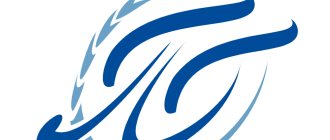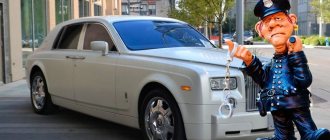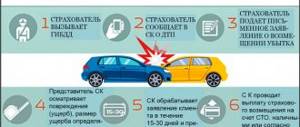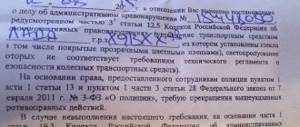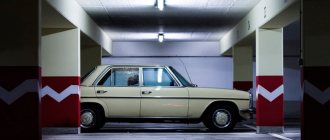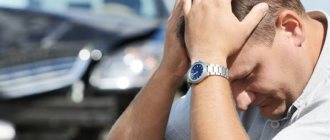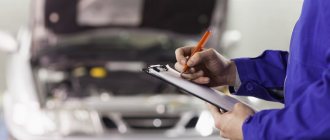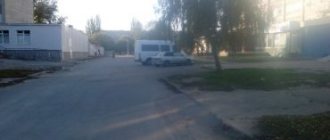Any car accident results in a number of problems for the driver, starting with the investigation to determine the guilty party in the conflict and ending with the process of repairing the damaged vehicle. And if the issue of determining the initiator of the accident falls entirely on the shoulders of traffic police inspectors, then restoring the car after an accident is the personal concern of the car owner. Moreover, this also applies to holders of an MTPL policy, since the insurance company can only offer the client a specific service station, and not make a choice for him. We will find out in the article how to properly assess the damage and where it is best to reconstruct the machine.
Basic driver actions after an accident
When involved in a traffic accident, the first thing a driver must do is make sure that no other participants in the accident were seriously injured. Next, before the State Traffic Inspectorate arrives, the motorist should fence off the collision site with special signs, and immobilize the vehicle itself by turning off the engine and applying the parking brake.
Upon the arrival of traffic police inspectors at the scene of the accident, the injured car owners draw up a written explanation, which will be used in the future to establish the culprit. The police may also interview witnesses (if any) and review dashcam footage.
Only after the traffic police officers draw up a report on the traffic accident, the driver will be able to contact the insurance company to receive a compensation payment. How in such a case the assessment of damage and further repair of a car after an accident occurs, we will consider below.
How much does it cost to repair a car after an accident?
If the accident did not occur through the fault of the driver and the insurer paid a certain amount rather than offering to restore the car at a service center and the cost of repairing the car is higher, the victim has the right and the insurer is obliged to equalize the compensation with the actual expenses incurred.
When turning to a service station for repairs using the money allocated by the insurer, the injured vehicle owner himself is responsible for who will return the car to its previous condition.
Auto body repair
Thus, body repair after an accident is assessed depending on the percentage of damage to body parts:
- Damage up to 30% – from 2,000 rubles (per part);
- From 30% – from 3,000 rubles;
- Door repair – from RUB 1,500. (depending on model).
Car painting
A vehicle damaged in a traffic accident and protected by insurance must, by law, be restored to its previous condition. If repairs after an accident require painting the entire body, and not its individual elements, then the company must allocate sufficient funds for this.
If individual parts can be painted on average from 3,000 rubles, then for the entire body it costs from 60,000 rubles.
Contacting the insurer
Regardless of which policy the motorist owns (MTPL or CASCO), he must notify the insurer about a traffic conflict that has arisen no later than 7 days from the date of the incident. You can do this in two different ways:
- Call the SK hotline;
- Contact the office of a company providing civil liability protection services.
It is important to know! In the first case, you should expect an independent expert to visit the scene of the accident, where all the necessary documents will be drawn up to receive compensation. When choosing the second option, the injured driver will have to collect all the certificates and papers on his own, which reduces his chances of full coverage of material damage from the insurance company.
Collection of documents
Before handing over your car after an accident for restoration by an insurance company, the driver must prepare the following documentation:
- Passport;
- Certificate of ownership of the car (a general power of attorney and deed of gift are also suitable);
- A valid CASCO or OSAGO policy;
- PTS;
- Driver license;
- Application for compensation;
- A traffic police resolution on a traffic accident, indicating the culprit of the accident.
Having received the listed certificates, the insurer can begin assessing the visible damage, for which the law allows him no more than 10 days. If the insurance company deliberately ignores these deadlines or the amount of compensation calculated by it is too small, then the car owner reserves the right to file a lawsuit against the company and conduct their own vehicle diagnostics with the involvement of another independent expert.
Damage assessment
As usual, the procedure for assessing material damage is carried out by a representative of the insurance company. But the legislation of the Russian Federation does not prohibit motorists from carrying out additional inspection of a mutilated vehicle with the involvement of an independent expert from a service station (at their own expense).
The total cost of car repairs after an accident is determined using the following algorithm:
- The appraiser carefully examines the vehicle body and records damage to the internal structure;
- The total cost of parts to be replaced is displayed, and the cost of restoration work is calculated;
- A percentage for wear of parts is subtracted from the resulting value (if the car is not repaired by a dealer).
It is important to know! If the driver agrees with the established amount of compensation, the insurance company can make a cash payment to the client or reconstruct the vehicle at its own expense. In the opposite situation, the citizen reserves the right to challenge the insurer’s decision in court and initiate a re-assessment of the damage.
Insurance repair process
When applying for an MTPL policy, the policyholder is provided with a list of car service stations. From there, the motorist can choose the most suitable auto repair shop for himself. Sometimes for some reason he does not receive the list. In this case, after an accident, the owner of the policy can ask for it at the office of the insurance company of the person responsible for the accident.
An insured event is processed in the following sequence:
- Receive a copy of the report on the occurrence of an insured event recognized as insurable. According to the law, the UK is given 3 days to provide this document. The report begins after receiving the relevant application.
- Within ten days, receive a conclusion about who is to blame for the accident.
- If the insurance company or service station requires additional documents regarding the car, they must be prepared (three days are allotted).
- Carrying out an examination of the damage caused to the vehicle (up to 5 days).
- Selection of a service station and delivery of the car there (3 days).
- Receiving a referral from the insurance company to restore the vehicle.
- Checking the work order, monitoring the compliance of real prices with the cost of spare parts and repair work.
- Waiting for vehicle repairs to be completed.
- Receiving a restored car.
In some cases, the insurance company insists on a specific car service or dealer. Cooperation with them is not always a bad option for the policyholder. In some cases, such service turns out to be of very high quality. If the policyholder wants to perform restoration work at a car service center with which the insurer does not have an agreement, he will be refused.
Restoring a car after an accident
All actions of insurers are regulated. The insurance company provides three points where you can repair a car after an accident under compulsory motor liability insurance:
- From an official dealer;
- At a bus station offered by the insurer;
- At the service station chosen by the client himself.
How the proposed options differ from each other, and which one is better for the victim to choose, we will consider below.
From an official dealer
Most often, owners whose vehicle has minimal mileage insist on having their car repaired at the dealer. After all, this can guarantee the high quality of the work performed. But insurance companies are reluctant to agree to this method of vehicle restoration, due to three main reasons:
- The price of parts at a dealer is much higher than on the market or in a regular car shop;
- The cost of a damaged car after repair will significantly decrease, even though the reconstruction will be carried out professionally;
- The average duration of a vehicle's stay in a car service is from 1 to 2 weeks, while dealers spend about 30-60 days on this process.
If the client insists on this option, then it is likely that the insurance company will refuse to restore his car at its own expense and will simply give the driver compensation in money.
To the service station in the direction of the insurance company
This method of car reconstruction is considered the most popular among insurance companies, as it allows them to save an impressive portion of compensation funds. The fact is that insurance companies issue referrals exclusively to those service stations with which they have an agreement, receiving in return lower rates for the restoration work themselves.
It is important to know! At the same time, the car owner also remains in the black, since the company’s regulations provide for a guarantee for the repairs performed. This means that if defects are detected, the driver will be able to make subsequent adjustments to the vehicle at the expense of the insurer, which is not offered by official dealers and private service stations.
Own choice of service station
As we mentioned earlier, the car owner himself has the right to choose where to have his car repaired after an accident under compulsory motor liability insurance. But in order to take the car to a service station under an insurance policy, the client needs to obtain consent from the insurance company. Based on this, it follows that the driver will not be able to restore the vehicle at any service station. The reason for a company to refuse a service station may be its banal lack of accreditation.
An additional disadvantage of this option is the removal of responsibility for the timing of repair work with the insurance company. Well, if there is a large difference between the cost of restoring a vehicle by the standards of a private bus station and the estimate drawn up by an insurance representative, the company may even file a lawsuit against the client, forcing him to conduct an independent examination at his own expense.
RECOVERY AFTER AN ACCIDENT
Toyota Verso 2014
On the car we did:
- repair and painting of the front right door;
- repair and painting of the rear right door.
The owner of a Toyota car sent photos of damaged parts on WhatsApp for a preliminary repair estimate. As you know, photographs do not convey the volume and extent of damage to a part. An estimate based on the photo is possible, however, it is approximate. So in this case, it seemed from the photographs that the degree of damage to the doors seemed simple or small. The body shop technician offered to come in for an inspection to make a final assessment of the repair. Upon visual inspection, it became clear that the degree of damage to the door surface was much more severe than it looked in the photo. On the front door, as a result of an accident, the metal stretched so much that a so-called slammer (playing metal or stretched metal) was formed. Lumps had also formed and the edge of the door was damaged by deep gouges. The rear door was less damaged, but also needed repair (straightening) and painting.
In the process of preparing car parts for repair, it turned out that it was necessary to order a disposable protective polyurethane film for the surface of the door, which is installed at the factory and the rivets for securing the gas tank flap. The gas tank flap must be removed to select the car enamel. On Toyota and Lexus cars, the hatches are riveted to the car body, and to subsequently install the hatch back you need a specialized tool.
The customer set us the following tasks:
- repair car doors;
- paint car doors;
- It was especially important for the customer that there was no color difference between the painted parts and unpainted body parts;
- Technologically correctly eliminate the flapper (playing metal or stretched metal).
During the car repair process, the following types of work were carried out:
- removing and installing the gas tank flap and comparing the color with the color of the body parts (to accurately select the color and shade of the paint);
- technological washing;
- selection of paint with preliminary test spraying;
- disassembly and assembly of car doors being repaired (removal of the opening handle, rear view mirror);
- repair (straightening) of the door surface;
- eliminating the flapper;
- preparation for painting (priming, sanding);
- painting and varnishing;
- polishing painted parts.
As mentioned above, the customer set the task of technologically correctly eliminating the flapper or, as tinsmiths say, to settle the stretched metal. There are different methods of upsetting stretched metal (OPM), we used the method of upsetting metal by heating using a graphite rod and a spotter, which is equipped in our body shop. As a result of eliminating the damage, the metal surface regained its original shape, and the part could be prepared for painting.
The following equipment was used to restore and repair the doors of this car:
- OKS (painting and drying chamber);
- Festool sanding machines for perfect surfaces;
- spotter (equipment for repairing body parts);
- IR drying;
- manual riveter.
If, for this damage, this repair method was not applied or the metal was left in the same condition as it was, then the surface of the door after painting would be curved, and upon careful examination, defects would be visible.
The customer was provided as a bonus:
- free parking until renovations begin;
- free touch-up of chips on the car body.
The cost of work to restore the car was 19,500 rubles, and the work took 6 days.
How is referral for repairs made?
After the victim submits all the necessary documents to the Investigative Committee, company representatives will have to inspect the mutilated vehicle within 5 days. Next, having in hand an estimate for the cost of repairs, an independent expert from the insurance company draws up a written referral to the service station, which is handed over strictly to the client.
Advice! The driver himself can decide to use the received document within 20 days. If a citizen, within the allotted time, does not have time to challenge the mentioned paper, or drive his car to the specified service station, then the possibility of restoring the vehicle under the MTPL policy will be canceled for him. And it will not be possible to resume it in the future even through the courts.
What is this?
Clients of insurance companies who have signed a compulsory motor liability insurance contract have the right to free restoration of their vehicle if they are the injured party in an accident. And if before 2021 the choice of the type of compensation depended on the policyholder, now it is practically non-existent. Repair of a car damaged as a result of an accident is approved by the Federal Law “On Compulsory Motor Liability Insurance”. Clause 21 of Article 12 states that restoration work must be carried out within 20 days.
The insurer usually sends the vehicle owner to a car repair shop with which it cooperates, but this does not negate the right of the victim to choose which service station to send his car to. At the same time, clients are always concerned about the question of whether they will have to pay extra for the workshop’s services. To ensure that no additional funds are required, the calculation based on expert assessments must be performed correctly .
In what cases is an independent examination needed?
Many drivers believe that an independent assessment after an accident is mandatory in order to avoid possible deception on the part of the insurance company. But in reality, this procedure is absolutely useless for persons who have submitted their vehicle for repairs on the direction of the insurer.
It’s another matter if a motorist decides to restore the car on his own, demanding monetary compensation from the company. Indeed, in this case, the estimated insurance amount will not always coincide with the actual cost of vehicle reconstruction. And in order not to pay extra money, a citizen needs to initiate an additional examination.
A person can contact the insurance company with a new estimate either through a lawsuit or pre-trial by sending a written claim. At the same time, it is better to start with the second option, since an amicable resolution of the conflict will allow the client to save a lot of time. And insurers in such situations prefer to agree to the conditions of the victims without provoking further proceedings.
Repair start dates
According to the internal regulations of insurance companies providing civil liability protection, the period for restoration work under compulsory motor liability insurance cannot exceed 30 days from the date of transfer of the vehicle to the service center employees. Additionally, this provision is regulated by the legislation of the Russian Federation, namely clause 15.2 of the “Law on Automobile Citizenship”. Ignoring it on the part of the insurance company may become the reason for a lawsuit filed on behalf of the client.
Attention! As a punishment, the company responsible for repairing the car under the insurance policy will incur losses in the amount of 1% per day of the total cost of vehicle reconstruction. And this penalty is assigned exclusively to the injured citizen. The only exception in this case can be considered the person’s refusal of the referral issued to him by the employees of the Investigative Committee.
Requirements for service stations
As we previously mentioned, when independently choosing a service station, the client must coordinate his decision with the insurer. In order not to receive a negative response from the insurance company, a citizen should make sure in advance that the service station he has chosen meets the following requirements:
- The service is located within 50 km from the vehicle owner’s residential address;
- Station employees guarantee order fulfillment within a 30-day period;
- Availability of accreditation;
- The service station provides a guarantee for the repairs performed (up to 1 year).
If one of the above criteria for car services is not met, then representatives of the insurance company have the right to refuse to pay the client monetary compensation in order to independently restore the car.
If the car is under warranty
If a person whose movable property is under warranty was injured in a traffic accident, then he will be able to receive compensation payment under compulsory motor liability insurance only after completing the following steps:
- While at the scene of an accident, the car owner must notify the insurance company about what happened and wait for the arrival of an independent expert;
- After completing a traffic police report and conducting a preliminary inspection of the damaged vehicle, the driver is obliged to report to the insurance company and submit an application for damages;
- Within 10 days from the moment of being involved in an accident, the motorist must submit his vehicle for extensive diagnostics in order to calculate the damage received.
It is important to know! As you can see, the procedure for receiving insurance payment for a car that is under warranty is not much different from the process of applying for compensation for a regular vehicle. The only thing that the owner of the mentioned car should pay attention to in this case is the timing of contacting the Investigative Committee.
We found out where you need to have your car repaired under warranty if it was involved in an accident, and during what period it is advisable to submit a claim to the insurance office. In conclusion, it is worth adding that if the internal regulations of OSAGO are not followed, a citizen may be refused compensation for material damage. And then he will have to cover the costs of restoration work exclusively from his own pocket.
Car repair after an accident: what you need to know
If the car is involved in an accident, an accident occurs due to the fault of another driver, then according to the Federal Law No. 40 “On Compulsory Motor Liability Insurance”, the initiator (or, in fact, the insurance company where the driver is insured) is obliged to cover the costs of repairing your car.
Insurers know their obligations towards the injured party as a result of a collision or accident, but they almost always try to reduce the compensation paid or refuse, shifting the obligation to pay to the person at fault for the accident.
Refusal to pay may occur:
- Alcohol intoxication;
- Intentionally causing damage;
- Failure to fasten seat belts during an accident, malicious traffic violations;
- Expired certificate of insurance.
Affected vehicle owners have the right to claim compensation payments:
- In monetary terms. If after an accident the car cannot be restored, is completely destroyed or repairs are not practical (more than 70% damage), then the victim receives money;
- In natural equivalent. If the vehicle suffered minor damage or moderate damage in the accident, then in most cases the car is sent for restoration repairs.
According to auto insurance law in 2021, car owners cannot choose between repairs or money in an accident, as this is determined depending on the situation and special provisions.
Compensation is due to the victim, and the culprit can have the car repaired under Casco.
